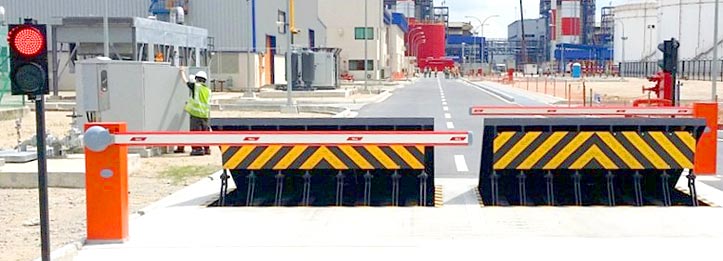The Ultimate Guide To Wedge Barriers

The Only Guide to Wedge Barriers
The continuing to be pressure applied to
the cam camera deploy the wedge plate 16 may be provided offered an electromechanical actuator 84 or other actuator. The spring assembly 54 and the actuator 84(e. Wedge Barriers. g., electromechanical actuator)may operate with each other to equate the web cam and lift the wedge plate 16.
As pointed out above, the spring setting up 54 exerts a constant force on the webcam, while the electromechanical actuator may be regulated to put in a variable force on the web cam, thus allowing the lifting and decreasing( i. e., deploying and pulling back )of the wedge plate 16. In certain embodiments, the constant force applied by the springtime setting up 54 might be adjustable. g., electromechanical actuator) is impaired. As will certainly be appreciated, the springtime assembly 54 might be covered and safeguarded from particles or various other components by a cover plate(e. g., cover plate 68 received FIG. 4) that may be substantially flush with the elevated surface 38 of the foundation 14. As stated above, in the deployed setting, the wedge plate 16 serves to obstruct gain access to or traveling beyond the barrier 10. For instance, the obstacle 10(e. g., the wedge plate 16 )may block pedestrians or lorries from accessing a building or pathway. As discussed above, the barrier 10 is important site affixed to the anchor 30 protected within the structure 14,

front brackets 71. Because of this, the linkage assemblies 72 may pivot and rotate to make it possible for the collapse and extension of the linkage assemblies 72 throughout retraction and deployment of the bather 10. The affiliation settings up 72 cause motion of the wedge plate 16 to be limited. If a lorry is traveling in the direction of the released wedge plate 16(e. For example, in one scenario, the safety and security legs 86 might be prolonged throughoutmaintenance of the barrier 10. When the safety and security legs 86 are deployed, the safety and security legs 86 sustain the weight of the wedge plate 16 versus the site link surface 12. Consequently, the training mechanism 50 might be shut off, serviced, removed, replaced, etc. FIG. 5 is partial perspective view of an embodiment of the surface-mounted wedge-style barrier 10, highlighting the cam 80 and the camera surfaces 82 of the lifting mechanism 50. Especially, two cam surfaces 82, which are referred to as lower webcam surfaces 83, are placed below the cam 80. The lower web cam surface areas 83 might be taken care of to the surface 12 (e. For instance, the lower web cam surfaces 83 and the placing plate 85 may develop site a single piece that is protected to the anchor 30 by bolts or various other mechanical fasteners. Furthermore, two camera surface areas 82, which are referred to as upper web cam surface areas 87, are placed above the webcam 80 and coupled to (e. In other personifications, stepping in layers or plates may be placed between the surface area 12 and the reduced cam surfaces 83 and/or the wedge plate 16 and the upper webcam surface areas 87 As stated over, the cam
80 converts along the webcam surfaces 82 when the wedge plate 16 is raised from the withdrawed setting to the deployed position. In addition, as pointed out over, the spring setting up 54 (see FIG. 3 )may supply a force acting upon the webcam 80 in the instructions 102 through spring pole 58, which might lower the force the electromechanical actuator 84 is required to apply to the webcam 80 in order to actuate and raise the wedge plate 16. 1 )to the deployed placement(see FIG. 4). As revealed, the webcam 80 consists of track wheels 104(e. g., rollers), which call and translate along the web cam surface areas 82 throughout operation.